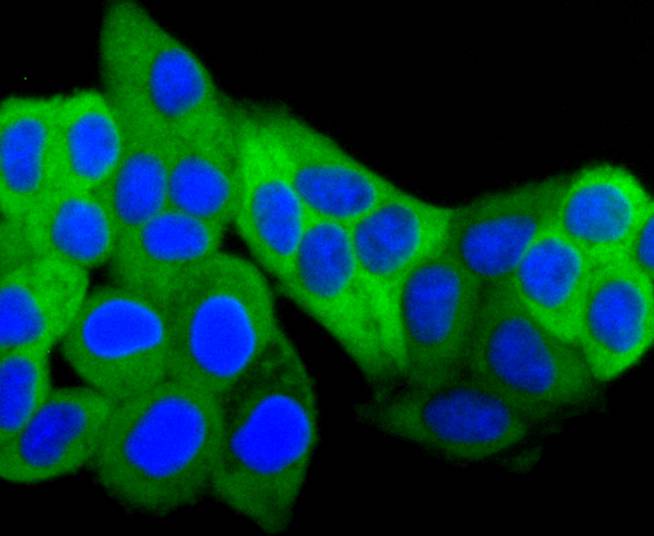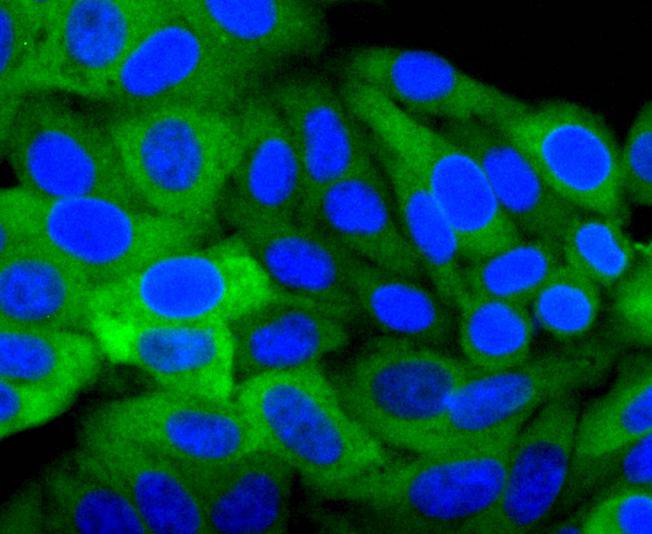Product Detail
Product NameHsp27 Rabbit mAb
Clone No.JJ09-13
Host SpeciesRecombinant Rabbit
Clonality Monoclonal
PurificationProA affinity purified
ApplicationsWB, ICC/IF, IHC, IP, FC
Species ReactivityHu, Ms, Rt
Immunogen Descrecombinant protein
ConjugateUnconjugated
Other NamesHeat shock 27kDa protein antibody 28 kDa heat shock protein antibody CMT2F antibody DKFZp586P1322 antibody epididymis secretory protein Li 102 antibody Estrogen regulated 24 kDa protein antibody Estrogen-regulated 24 kDa protein antibody Heat shock 25kDa protein 1 antibody Heat shock 27 kDa protein antibody Heat shock 27kD protein 1 antibody Heat shock 27kDa protein 1 antibody Heat shock 28kDa protein 1 antibody Heat Shock Protein 27 antibody Heat shock protein beta 1 antibody Heat shock protein beta-1 antibody heat shock protein family B (small) member 1 antibody HEL-S-102 antibody HMN2B antibody HS.76067 antibody Hsp 25 antibody HSP 27 antibody Hsp 28 antibody Hsp B1 antibody Hsp25 antibody HSP27 antibody Hsp28 antibody HspB1 antibody HSPB1_HUMAN antibody SRP27 antibody Stress responsive protein 27 antibody Stress-responsive protein 27 antibody
Accession NoSwiss-Prot#:P04792
Uniprot
P04792
Gene ID
3315;
Calculated MW27 kDa
Formulation1*TBS (pH7.4), 1%BSA, 40%Glycerol. Preservative: 0.05% Sodium Azide.
StorageStore at -20˚C
Application Details
WB: 1:1,000-1:2,000
IHC: 1:50-1:200
ICC: 1:100-1:500
FC: 1:50-1:100
Western blot analysis of Hsp27 on A549 cells lysates using anti-LRP1 antibody at 1/1,000 dilution.
Immunohistochemical analysis of paraffin-embedded human tonsil tissue using anti-Hsp27 antibody. Counter stained with hematoxylin.
Immunohistochemical analysis of paraffin-embedded human colon cancer tissue using anti-Hsp27 antibody. Counter stained with hematoxylin.
Immunohistochemical analysis of paraffin-embedded human breast carcinoma tissue using anti-Hsp27 antibody. Counter stained with hematoxylin.
ICC staining Hsp27 in Hela cells (green). The nuclear counter stain is DAPI (blue). Cells were fixed in paraformaldehyde, permeabilised with 0.25% Triton X100/PBS.
ICC staining Hsp27 in HepG2 cells (green). The nuclear counter stain is DAPI (blue). Cells were fixed in paraformaldehyde, permeabilised with 0.25% Triton X100/PBS.
Flow cytometric analysis of Hela cells with Hsp27 antibody at 1/50 dilution (red) compared with an unlabelled control (cells without incubation with primary antibody; black). Alexa Fluor 488-conjugated goat anti rabbit IgG was used as the secondary antibody.
The heat shock proteins (HSPs) comprise a group of highly conserved, abundantly expressed proteins with diverse functions, including the assembly and sequestering of multiprotein complexes, transportation of nascent poly-peptide chains across cellular membranes and regulation of protein folding. Heat shock proteins (also known as molecular chaperones) fall into six general families: HSP 90, HSP 70, HSP 60, the low molecular weight HSPs, the immunophilins and the HSP 110 family. The low molecular weight family includes HSP 10, HSP 20, HSP 27, HSP 32 and HSP 40. HSP 27 is a constitutively expressed cytoplasmic protein that co-localizes to the nucleus upon stress induced by insult. Heat, cytokines and hormones are among the factors that stimulate the synthesis of HSP 27. In vitro, HSP 27 becomes highly phosphorylated following exposure to stress. The discovery that HSP 27 is regulated by hormones such as estrogen has led to studies establishing a relationship between HSP 27 and breast cancer.
If you have published an article using product 49283, please notify us so that we can cite your literature.
et al,Tumor cell-released autophagosomes (TRAPs) induce PD-L1-decorated NETs that suppress T-cell function to promote breast cancer pulmonary metastasis. In J Immunother Cancer on 2024 Jun 26 by Xiaohe Zhou, Chengdong Wu,et al..PMID:38926151
, (2024),
PMID:
38926151









 Yes
Yes



